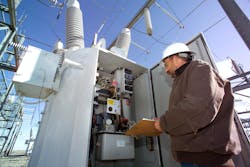Credit: Idaho National Laboratory
Grid-connected microgrids earn revenue by selling what are known as ‘ancillary services’ to the central grid. These services help keep power flowing in a stable fashion. Offering these services makes a microgrid valuable well beyond the buildings it powers. The microgrid becomes an asset to society at large. Read more in the following excerpt from our new Think Microgrid report, The Energy Efficient Microgrid.
We tend to think that electric production and distribution is a fairly straight forward process. A power plant generates electricity and sends it over wires to buildings and homes.
In fact, keeping the lights on is an intricate act of constant monitoring and correction. In North America, much of this work is done by 10 grid operators, also known as regional transmission organizations.
The grid operators oversee wholesale energy markets that serve about two thirds of North America.
In addition to dispatch of power, the grid operators undertake several other activities to keep the lights on. These include maintaining grid frequency and voltage, and balancing between supply and demand. Given the dynamism of our electric system – lights on and off, air conditioning up and down, computers and other electronic devices plugging in and out – grid management must be minute-by-minute to ensure electricity is constantly available.
In addition, the grid operator must look years ahead to make sure utilities, power plant developers, energy efficiency companies, and others plan to build or add enough capacity to keep up with future demand.
To make all of this work, the grid operator buys services from various entities, among them grid-connected microgrids.
Perhaps the most well-known of these services is demand response – where the grid operator or utility pays energy users to use less energy when the grid is under strain. Another is the capacity market, which pays for the guarantee that power will be available when needed. Others are ancillary services and may include regulation, synchronized reserve, black start capabilities, voltage support and similar assistance.
Microgrids provide some of these services; this is one way how microgrids earn revenue.
In this way, a grid-connected microgrid strengthens the grid, and the grid in turn contributes to the microgrid’s financial wherewithal.
The microgrid may also act as a customer of the grid, buying power from the grid when its own generators are down for repair or when grid prices are more favorable than self-supply.
So when operating in parallel with the grid, microgrids offer a best-of-both worlds. Microgrids are good for the buildings and businesses they serve – and for everybody else as well.
The Energy Efficient Microgrid: What Combined Heat & Power and District Energy Bring to the Microgrid Revolution is provided as a free download, courtesy of Solar Turbines and the International District Energy Association.







